
The Hokan language family is a hypothetical grouping of a dozen small language families spoken mainly in California, Arizona, and Baja California.

Penutian is a proposed grouping of language families that includes many Native American languages of western North America, predominantly spoken at one time in British Columbia, Washington, Oregon, and California. The existence of a Penutian stock or phylum has been the subject of debate among specialists. Even the unity of some of its component families has been disputed. Some of the problems in the comparative study of languages within the phylum are the result of their early extinction and limited documentation.

Mary Rosamond Haas was an American linguist who specialized in North American Indian languages, Thai, and historical linguistics. She served as president of the Linguistic Society of America. She was elected a fellow of the American Academy of Arts and Sciences and a member of the National Academy of Sciences.
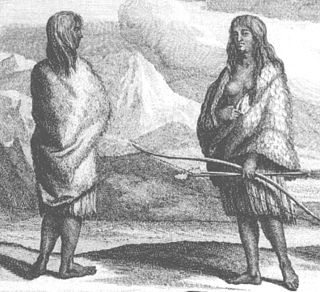
The Pericú were the aboriginal inhabitants of the Cape Region, the southernmost portion of Baja California Sur, Mexico. They have been linguistically and culturally extinct since the late 18th century.

Yokuts, formerly known as Mariposa, is an endangered language spoken in the interior of Northern and Central California in and around the San Joaquin Valley by the Yokuts people. The speakers of Yokuts were severely affected by disease, missionaries, and the Gold Rush. While descendants of Yokuts speakers currently number in the thousands, all constituent dialects except for Valley Yokuts are now extinct.

The Yuman–Cochimí languages are a family of languages spoken in Baja California, northern Sonora, southern California, and western Arizona. Cochimí is no longer spoken as of the late 18th century, and most other Yuman languages are threatened.

Chumashan was a family of languages that were spoken on the southern California coast by Native American Chumash people, from the Coastal plains and valleys of San Luis Obispo to Malibu, neighboring inland and Transverse Ranges valleys and canyons east to bordering the San Joaquin Valley, to three adjacent Channel Islands: San Miguel, Santa Rosa, and Santa Cruz.
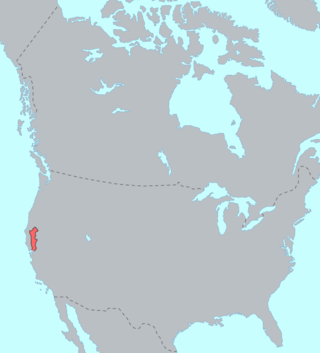
Wintuan is a family of languages spoken in the Sacramento Valley of central Northern California.

The Yuki–Wappo or Yukian languages are a small language family of western California consisting of two distantly related languages, both now extinct.

The Guaycura were a native people of Baja California Sur, Mexico, occupying an area extending south from near Loreto to Todos Santos. They contested the area around La Paz with the Pericú. The Guaycura were nomadic hunter-gatherers. They are distinguished by a language unrelated to any other Native American language, indicating in the opinion of some linguists that their ancestry in Baja California dates back thousands of years.
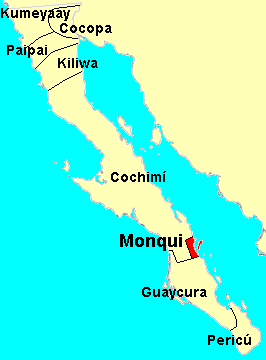
The Monqui were indigenous peoples of Mexico, who lived in the vicinity of Loreto, Baja California Sur, Mexico, at the time of Spanish contact. Monqui territory included about 65 kilometres (40 mi) of coast along the Gulf of California and extended a few kilometers inland to where the Cochimi people lived.

The Cochimí were the indigenous inhabitants of the central part of the Baja California peninsula, from El Rosario in the north to San Javier in the south. Information on Cochimí customs and beliefs has been preserved in the brief observations by explorers but, above all, in the writings of the Jesuits. Particularly important and detailed are the works of Miguel Venegas and Miguel del Barco (1973).
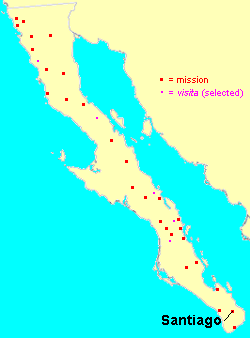
Mission Santiago was founded by the Italian Jesuit Ignacio María Nápoli in 1724 and financed by the Marqués de Villapuente de la Peña and his wife the Marquesa de las Torres de Rada, at the native settlement of Aiñiní, about 40 kilometers north of San José del Cabo in the Cape Region of Baja California Sur, Mexico.

The Kiliwa are an indigenous people of Mexico living in northern Baja California. Historically they occupied a territory lying between the Cochimí on the south and the Paipai on the north, and extending from San Felipe on the Gulf of California to San Quintín on the Pacific coast. Their traditional language is the Kiliwa language.
Kiliwa, alternate Names: Kiliwi, Ko’lew or Quiligua is a Yuman language spoken in Baja California, in the far northwest of Mexico, by the Kiliwa people.
Cochimí was once the language of the greater part Baja California, as attested by Jesuit documents of the 18th century. It seems to have become extinct around the beginning of the 20th century There were two main dialects, northern and southern; the dividing line was approximately at the Misión San Ignacio Kadakaamán, in the north of present-day Baja California Sur.
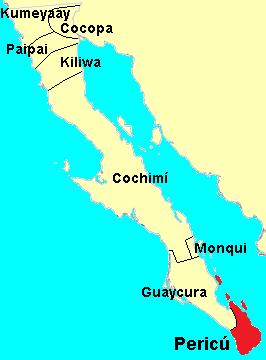
Pericú is the extinct and essentially unattested language of the Pericú people who lived at the southern tip of Baja California Sur. Jesuit missionaries recognized it as distinct from Waikuri (Guaycura) immediately to the north. It was spoken in the mountainous area around the mission of San José del Cabo, on the southeastern coast from Santiago to La Paz, and on the islands off the east coast as far north as Isla San José.
Victor Golla (1939–2021) was a linguist and a leading expert on the indigenous languages of California and Oregon, especially the Pacific Coast Athabaskan subgroup of the Athabaskan language family and the languages of the region that belong to the Penutian phylum. He was emeritus professor of anthropology at Humboldt State University and lived in Trinidad, California.
The Pakawan languages were a small language family spoken in what is today northern Mexico and southern Texas. All Pakawan languages are today extinct.
The Takelma–Kalapuyan languages are a proposed small language family that comprises the Kalapuyan languages and Takelma, which were formerly spoken in the Willamette Valley and the Rogue Valley in Oregon.















